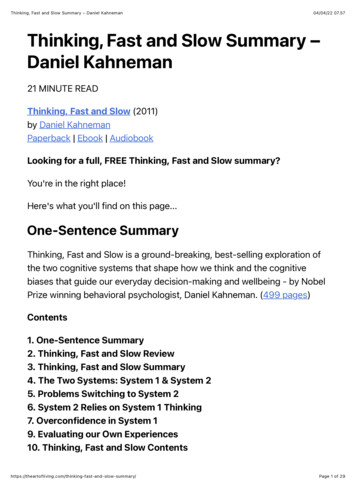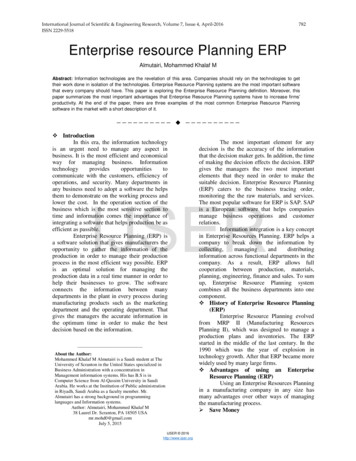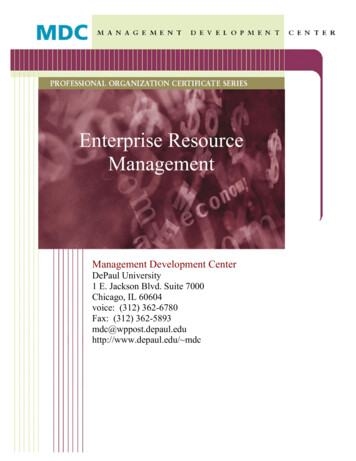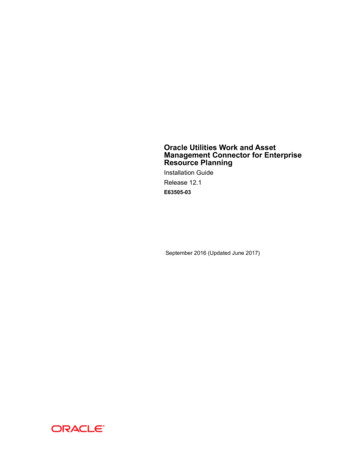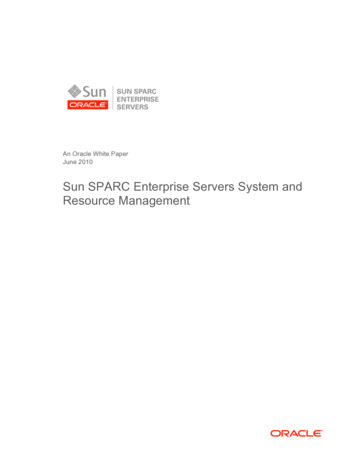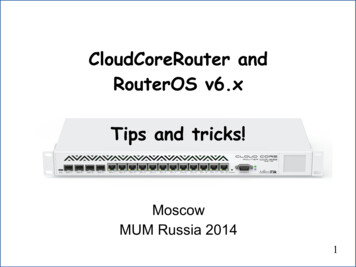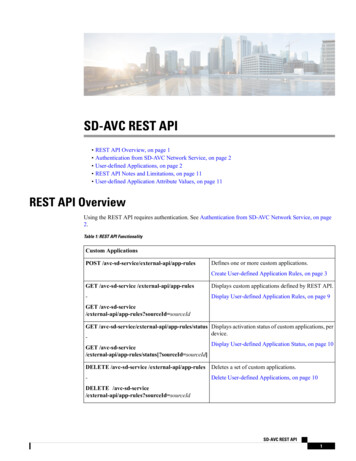
Transcription
HOW FAST ARE ENTERPRISE RESOURCE PLANNING (ERP) SYSTEMS MOVING TO THE CLOUD?Journal of Information Technology ManagementISSN #1042-1319A Publication of the Association of ManagementHOW FAST ARE ENTERPRISE RESOURCE PLANNING (ERP)SYSTEMS MOVING TO THE CLOUD?AL BENTOUNIVERSITY OF BALTIMOREabento@ubalt.eduREGINA BENTOUNIVERSITY OF BALTIMORErbento@ubalt.eduANA BENTOTHE JOHNS HOPKINS UNIVERSITY APPLIED PHYSICS LABORATORYAna.Bento@jhuapl.eduABSTRACTEnterprise Resource Planning (ERP) systems evolved from traditionally isolated applications such as payroll,billing, purchasing, sales, etc. – that neither shared a common base of data, nor interacted well with one another. The needfor an integrated view of enterprise systems led to the development of sophisticated and complex software packages thatcould be tailored for different organizations and provide different modules (e.g. Human Resources, Financial/Accounting,and Logistics), that would interact with one another and use a common base of data. ERP systems were leased or purchased,tailored and installed as in-house computer systems resisting industry outsourcing trends.Cloud Computing, and particularly Software as a Service (SaaS), is moving in-house systems to Private and PublicClouds. Sixty percent of the organizations studied already use Cloud services. Customers Relationship Management (CRM)is prominent among the services moved to the Cloud, but close to 20% of the organization respondents moved the ERPmodules of human resources and financial/account systems to the Public Cloud. New ERP development is increasinglyCloud-based, while conventional in-house ERP is decreasing.The factors that are motivating the move to the Cloud as reported by 40% of the respondents are faster access to newfunctionality, increase in revenue by offering new products sooner, better resource utilization, decrease of IT costs, anddecentralization.Finally, the factors that are hindering the move to the Public Cloud as perceived by over 30% of the respondents aresecurity, regulations, reliability, capability and maturity of Cloud services, in addition to IT governance and SLAs.Keywords: ERP, Cloud Computing, SaaS, SCM, CRMThis article was originally presented at the 2014 Cambridge Business & Economics Conference, Cambridge, UK, July 2014.Journal of Information Technology Management Volume XXVI, Number 4, 201535
HOW FAST ARE ENTERPRISE RESOURCE PLANNING (ERP) SYSTEMS MOVING TO THE CLOUD?INTRODUCTIONEnterprise Resource Planning (ERP) Systems arelarge resource intensive IT business projects donetraditionally in-house, resisting the trend for IT/ISoutsourcing and offshoring [24]:“Enterprise resource planning (ERP) systems aresoftware packages composed of several modules,such as human resources, sales, finance andproduction, providing cross organizationintegration of information through embeddedbusiness processes. These software packages canbe customized to cater for the specific needs ofan organization. During the 1990s, ERP systemsbecame the de facto standard for replacement oflegacy systems in large and particularlymultinational companies.” [15]A 2011 study found that there are differences inthe age of ERP systems, particularly in mid-sizedcompanies, as seen in Figure 1.Source: Prouty [16]Cloud Computing offers a real possibility ofrunning these systems on the Cloud with the ERPmanagement in-house, but without the need for costly andtime-consuming upgrades, maintenance, and capitalexpenditures, which will be done by the Cloud ERPproviders once ERP systems are moved to the Cloud.Businesses have invested large financial and timeresources to develop their current in-house ERP systems,but the next upgrade may make the move to the Cloudcost effective. Most businesses choose to move servicesto the Cloud primarily because of cost savings and bettersystem performance [10].ERP in the cloud is primarily Software as aService (SaaS) – “a software delivery model in whichsoftware and associated data are centrally hosted on thecloud” [22]. The SaaS market had worldwide revenues of 13.1 billion in 2009, and the market was forecast toreach 40.5 billion by 2014, representing a compoundannual growth rate of 25.3%. In 2014, about 34% of allnew business software purchases was expected to beconsumed via SaaS and SaaS delivery was predicted toconstitute about 14.5% of worldwide software spendingacross all primary markets [12]. Forrester Research foundthat Cloud-based ERP in 2011 comprised around 2percent of the market, but was set to grow by about 21percent annually through 2015 [13].Moving ERP to the Cloud provides a simpleway to implement a two-tier ERP – with one ERPinstallation for the company headquarters and other localERP installations for subsidiaries, decreasing the risks offailure, decreasing the overall installation time, increasingthe agility of the implementation and updating process[5]. In addition, moving ERP to the Cloud facilitates themobile access to ERP that is a requirement of theincreasing phenomenon of a mobile workforce andmobile customer [18].ERP system software expenditure continues togrow and the number of players has increased toaccommodate the move to the Cloud, adding newproviders. The traditional providers – SAP and Oracle –still have the largest market share, as shown in Figure 2.Figure 1: Age of ERP systemsJournal of Information Technology Management Volume XXVI, Number 4, 201536
HOW FAST ARE ENTERPRISE RESOURCE PLANNING (ERP) SYSTEMS MOVING TO THE CLOUD?Source: Columbus [2]Figure 2: ERP software market shareThe growth of Cloud-based ERP systems isprojected to be greater than the traditional ERP in-housesystems, from 12% in 2014 to 17% in 2017, but they varyby type of ERP system moved to the Cloud as shown inTable 1.This study examines how fast ERP systems aremoving to the Cloud, and the factors that are affecting thismovement. The literature identifies a series of factors thatmay hinder or facilitate the move of ERP systems to theCloud. The first bar chart below (Figure 3) shows someof the potential factors facilitating the move in large-sizeorganizations. The second bar chart (Figure 4) shows thereasons why mid-sized companies choose to move to theCloud.Finally, recent surveys seem to indicate thatCFOs (Chief Financial Officers) support and encouragethe move of ERP to the Cloud:“The reality is that CFOs not only understand thecloud’s benefits, but are embracing it faster andmore broadly than many originally thoughtpossible, including new services such asenterprise resource planning (ERP) in the cloud.”[14]Journal of Information Technology Management Volume XXVI, Number 4, 201537
HOW FAST ARE ENTERPRISE RESOURCE PLANNING (ERP) SYSTEMS MOVING TO THE CLOUD?Table 1: Growth of ERP systemsFigure 3: Factors facilitating the move to the cloud (large organizations)Journal of Information Technology Management Volume XXVI, Number 4, 201538
HOW FAST ARE ENTERPRISE RESOURCE PLANNING (ERP) SYSTEMS MOVING TO THE CLOUD?Figure 4: Factors facilitating the move to the cloud (mid-sized organizations) RESEARCH QUESTIONSThere is extensive research on ERP systems, asevidenced by 885 peer reviewed journal publications from2000 to 2009, with many more in recent years. The mainstreams of these published journal articles were [20]: Implementation -- criteria to select the ERPsystem provider, strategy to be used, processreengineering prior or simultaneously, andcritical success factors (CSF). Optimization and post-implementation –processimprovement,maintenance,benefits. Management and organization – functionalvs IT vs providers relations andarrangements.ERP, SCM and CRM integration – how canERP be connected to Supply ChainManagement (SCM) and to CustomersRelationship Management (CRM) softwareand processes.Education and training – academic andprofessional development of ERP skilledpersonnel.Another way to look at the major streams of ERPresearch is summarized in Figure 5.Journal of Information Technology Management Volume XXVI, Number 4, 201539
HOW FAST ARE ENTERPRISE RESOURCE PLANNING (ERP) SYSTEMS MOVING TO THE CLOUD?Source: Grabski, Leech, & Schmidt [6, Figure 1].Figure 5: ERP research streamsThe present study goes beyond the scope oftraditional ERP research using the results of a large scalesurvey to analyze how large organizations areapproaching the process of moving ERP to the Cloud:how fast they are doing it, and to what extent they plan todo so. In addition, the study attempts to identify whatfactors may hinder or facilitate the move of ERP to theCloud. The study’s overall research questions are:1. How fast are ERP systems moving to the Cloud?2. What factors may be hindering or facilitatingERP systems’ move to the Cloud?RESULTS AND CONCLUSIONSWe used secondary data to answer the researchquestions, since we were not able to obtain direct datafrom large organizations. The analysis and conclusions ofthis study are based on Fauscette’s [4] study of IDC’sCloudTrack Survey of 1,109 respondents of large sizeorganizations regarding the move of ERP to the Cloud.Fauscette studied ERP as another type of SaaS and anevolutionary process of moving traditional internalsoftware systems to the Cloud. Organizations initiallylearned to use SaaS through CRM, which in the studyresults are still the dominant form of software servicesmoved to the Cloud.How fast are ERP systems moving to theCloud?The speed of ERP systems moving to the Cloudfollows the overall pattern of SaaS adoption.“Slowly over time SaaS and cloud computinghave moved into the mainstream of IT operationsand are increasingly becoming preferredalternatives to on-premises deployments. In factover 60% of companies surveyed by IDCreported that they were already using or had firmplans to use cloud services (IDC's CloudTrackSurvey, October 2013, n 1,109)” [4]The CloudTrack survey shows that a significantdecrease of conventional ERP deployment and increase ofprivate and public cloud deployments is planned, asshown in Figure 6. While both human resource andfinancial/accounting ERP applications are moving moretoward the private cloud than the public cloud, it isinteresting to note that most of the increase in publiccloud deployment is in the area of ERP human resourceapplications.Journal of Information Technology Management Volume XXVI, Number 4, 201540
HOW FAST ARE ENTERPRISE RESOURCE PLANNING (ERP) SYSTEMS MOVING TO THE CLOUD?Figure 6: Move of applications to the private and public cloudERP applications are already used in the publiccloud by a significant percentage of the studiedenterprises, although they still lag behind CRMapplications, as shown in Table 2.Table 2: Applications most used by respondentsin the public cloudMost Used ApplicationsPercent ofrespondentsCRM applications (marketing21.2%automation/sales automation)CRM applications(call20.9%center/contact center)Supply chain and logistics19.6%Enterprise resource planning (human19.3%resource applications)Enterprise resource planning18.9%(financial/accounting applications)n 1,109Source: IDC's CloudTrack Survey, October 2013 as citedin Fauscette [4].Significant progress has already been made, butit seems that ERP is moving to private, hybrid and publicclouds only as new applications are developed and/orupgraded. It does not seem to be a wholesale decision tomove to the Cloud, but rather an incremental move, asneeded, dictated by business, financial or technologychanges.What factors may be hindering or facilitatingERP systems move to the Cloud?As expected from prior discussions, the mainfactors motivating the ERP move to the Cloud are eitherfaster access to new technology, financial benefits, oragility in developing local IT ERP solutions, assummarized in Table 3.Journal of Information Technology Management Volume XXVI, Number 4, 201541
HOW FAST ARE ENTERPRISE RESOURCE PLANNING (ERP) SYSTEMS MOVING TO THE CLOUD?Table 3: Factors motivating ERP move to thecloudTop Factors motivating ERPPercent ofmove to the CloudrespondentsGet access to the newest41.3%functionality fasterIncrease revenue by enabling us tobuild new revenue-generating40.5%products and services fasterImprove resource utilization40.4%Reduce the total size of IT budget40.3%Give business units more directcontrol over sourcing their own IT39.0%solutionsn 1,109Source: IDC's CloudTrack Survey, October 2013 as citedin Fauscette [4].Unexpectedly, human resource issues (IT forcedisplacement) were not seen as a top factor hindering themove to the cloud. Security, regulations, reliability,capability and maturity of Cloud services, in addition toIT governance and Service Level Agreements (SLAs),were seen as the main obstacles of the move to the PublicCloud, as detailed in Table 4.Table 4: Factors hindering ERP move to thecloudTop Factors hindering move toPercent ofPublic CloudrespondentsSecurity concerns49.0%Regulatory or compliance issues35.3%Reliability concerns in terms of32.9%service availabilityConcerns that cloud cannot supportthe operational/performance32.3%requirements of critical applicationsIT governance issues, includingchallenges related to defining31.0%standard services and SLAsImmaturity of cloud–it is a new30.7%technologyn 1,109Source: IDC's CloudTrack Survey, October 2013, as citedin Fauscette [4].ConclusionsThe ERP move to the Cloud is under way, not asa wholesale decision, but rather as a business,technological or financial need arises. The move to theCloud, although incremental, is happening whenever newdevelopment is required, at the same time that traditionalin-house systems development decreases, as seen inFigure 6. One of the factors hindering the move to thecloud is the existing investment in in-house systems,which may explain the incremental nature of this move.The top factor hindering the wholesale move tothe cloud was Security, with nearly half of the surveyrespondents stating that it was a major factor hinderingthe move of ERP to the public cloud. This may explainwhy the greatest growth in ERP in the cloud has been inthe private cloud, rather than the public cloud. It is alsointeresting to note that the relative novelty of Cloudtechnology and services was one of the top factorshindering the move to the public cloud, despite the factthat 60% of the respondents are already using or planningto use Cloud services.The use of ERP in the Public Cloud is /Accounting applications as reported by close to20% of the respondents. Recent growth of ERP use in thePublic Cloud has been greater within Human gapplications, which are increasing mostly in the use of thePrivate Cloud. Future research should look further intothe reasons why these two categories of ERP applicationsare increasingly moving to the cloud, and why other ERPapplications are not.A recent study from Price Waterhouse Coopers[1] seems to indicate that Cloud ERP growth has beenaccelerating in 2015, with revenue of cloud-based andhybrid (cloud and in-house) ERP surpassing traditionalin-house ERP. Columbus [3] summarized the factorsaccelerating this growth as: support of new businessmodels, hybrid ERP systems saving up to six times theamount of capital expenditure over traditional ERPsystems, and the increased complexity of businesssystems extended to the Cloud, among others.REFERENCES[1][2]Clark,N., Dawson,D., Heard, K., and Manohar,M(2015). Beyond ERP: New technology, newoptions, accessed September 6, 2015, [available -ERP.pdf]Columbus, L. (2014). Gartner's ERP Market ShareUpdate Shows The Future Of Cloud ERP Is Now,accessed September 6, 2015, [available ure-of-cloud-erp-is-now/]Journal of Information Technology Management Volume XXVI, Number 4, 201542
HOW FAST ARE ENTERPRISE RESOURCE PLANNING (ERP) SYSTEMS MOVING TO THE ]Columbus, L. (2015). Five Catalysts AcceleratingCloud ERP Growth In 2015, accessed September 6,2015, [available n-2015/print/]Fauscette, M. (2013). ERP in the Cloud and theModern Business, accessed September 6, 2015,[available 111292 ERP US EN WP IDCERPInTheCloud.pdf]Gill, R. (2011). The Rise of Two-Tier ERP: What itis and what it means. Strategic Finance, November2011, 35-40.Grabski, S.V., Leech, S.A., & Schmidt, P.J. (2011).A Review of ERP Research: A Future Agenda forAccounting Information Systems. Journal ofInformation Systems, 25(1), 37-78.Ioannou, G., & Papadoyiannis, C. (2004). Theoryof constraints-based methodology for effective n Research, 42(23), 4927-4954.Jimenez, D.-Z., & Lee, W. (2011). d's ERP Upgrade Journey - APEJ View.IDC #AP2670107T, April 2011.Jutras, C. (2010). ERP in SME: Fueling Growthand Profits. Aberdeen Group, August 2010.Koehler, P., Anandasivam, A., & Dan, M. (2010).Cloud Services from a Consumer Perspective.AMCIS 2010 Proceedings, Paper 329.Kumar, K., & Van Hillegersberg, J. (2000). ERPExperiences and Evolution, Communications of theACM, 43(4), 23-26.Manchester. (2010). IDC: One Third of AllSoftware Delivered via Cloud in 2014, accessedSeptember 6, 2015 [available all-software-delivered-via-cloud-in-2014]Martens, C., Hamerman, P.D., Moore, C., Magarie,A. (2011). The State Of ERP In 2011: CustomersHave More Options In Spite Of MarketConsolidation, accessed November 24, 2013,[available athttp://www.forrester.com/rb/Research/state of erpin 2011 customers have/q/id/55901/t/2]Miranda, S. (2013). ERP in the Cloud: CFOs Seethe Value of Running Enterprise Applications as aService. Financial Executive, Jan/Feb 2013, 65-66.Nazemi, E., Tarokh, M.J., & Djavanshir, G.R.(2012). ERP: a literature survey. ournal of Advanced Manufacturing Technology,61, 999-1018.Prouty, K. (2011). Aging ERP: When Old ERP isToo Old. Aberdeen Group, June 2011.Prouty, K., & Castellina, N. (2011). To ERP or Notto ERP: In Manufacturing, It Isn't Even a Question.Aberdeen Group, April 2011.Prouty, K., & Castellina, N. (2011). Mobility inERP 2011. Aberdeen Group, May 2011.Sage North America. (2011). ERP and the Cloud:What You Need to Know.Schlichter, B.R., & Kraemmergaard, P. (2010). Acomprehensive literature review of the ERPresearch field over a decade. Journal of EnterpriseInformation Management, 23(4), 486-520.Shaul, L., & Tauber, D. (2013). Critical successfactors in enterprise resource planning systems:Review of the last decade. ACM ComputingSurveys, 45(4), Article 55, 39 pages.Software as a service. (2013). In Wikipedia,accessed November 24, 2013, [available athttp://en.wikipedia.org/wiki/Software as a service]Sternad, S., Gradisar, M., & Bobek, S. (2011). Theinfluence of external factors on routine ERP usage.Industrial Management and Data Systems, 111(9),1511-1530.Wiener, M., Vogel, B., & Amberg, M. (2010).Information Systems Offshoring - A LiteratureReview and Analysis. Communications of theAssociation for Information Systems, 27(1), 455492.AUTHOR BIOGRAPHIESAl Bento is Professor Emeritus of InformationSystems, University of Baltimore. He was previously onthe faculty of Boston University School of Management,Bentley University, and California State University. Hehas served as Department Chair and Research CenterDirector in these institutions. Prior to his academic career,he worked for nine years at IBM World Trade as SystemsEngineer, Budget Manager, and Education and ScientificAffairs Manager. He has also served the profession andthe University in a variety of capacities, such as Chair ofthe Association for Information Systems (AIS) SpecialInterest Group on Security (SIGSEC), AMCISConference track and mini-track Chair, Webmaster andFaculty Senate President of the Merrick School ofBusiness. He holds a B.S.B.A, an M.S. in ComputerScience and Systems Engineering, and a Ph.D. inManagement, Computer Information Systems from theUniversity of California, Los Angeles (1980).Journal of Information Technology Management Volume XXVI, Number 4, 201543
HOW FAST ARE ENTERPRISE RESOURCE PLANNING (ERP) SYSTEMS MOVING TO THE CLOUD?Regina Bento is a Professor of Management atthe Merrick School of Business, University of Baltimore.Born and raised in Brazil, she started her career as apsychiatrist (M.D., Federal University of Rio de Janeiro UFRJ, 1977), studying the relationship between work andmental health. Interested in learning more about thenature of work and organizations, she went on to pursuegraduate studies in administration. After an M.S. inManagement (COPPEAD, UFRJ, 1979), she came to theUnited States for doctoral studies at Harvard and MIT(Ph.D. Sloan School of Management, MIT, 1990). Shehas been a faculty member at UB's Merrick School ofBusiness since 1991, and before that she taught atCOPPEAD/ UFRJ (1980-1983) and UC Riverside (19881991). She was also a Visiting Professor at the SloanSchool, MIT (1999, 2007) and Associate Director of theChristensen Center for Teaching and Learning at HarvardBusiness School (2006-2009). Regina has receivednumerous teaching and research awards, including theUSM Regents Award, the highest honor in the UniversitySystem of Maryland.Ana Bento is Software Security Engineer at TheJohns Hopkins University Applied Physics Laboratory.She earned her Master's in Information Systems SecurityTechnology and Management at the Carnegie MellonUniversity in 2006, and her Bachelor's in ComputerEngineering at the University of Maryland, College Parkin 2004. Her research interests include network security,control systems, performance measurement, modeling andsimulation, and operating system reliable kernels.Journal of Information Technology Management Volume XXVI, Number 4, 201544
Enterprise resource planning (human resource applications) 19.3% Enterprise resource planning (financial/accounting applications) 18.9% n 1,109 Source: IDC's CloudTrack Survey, October 2013 as cited in Fauscette [4]. Significant progress has already been made, but it seems that ERP is moving to private, hybrid and public
